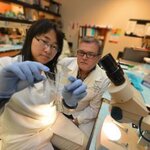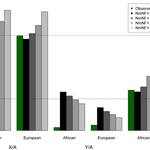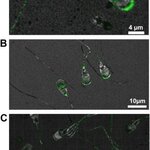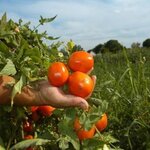Genetics & Molecular Biology

Going barefoot in parts of Africa, Asia and South America is dangerous.
Hookworms live in the soil and enter the body through the feet. By feeding on victims' blood, the worms cause anemia and, in children, stunted growth and learning problems. These infections afflict an estimated 700 million of the world's poor.
Researchers have decoded the genome of the hookworm, Necator americanus, finding clues to how it infects and survives in humans. Necator americanus causes about 85 percent of human hookworm infections, which are not usually fatal. However, in pregnant women, the worm can…

How do we estimate the confidence range about an estimate? In normal probability theory, we take a distribution and directly measure the dispersion within the data. This dispersion is not influenced by the central location of the distribution, though we see in the previous linked note that the shape and of course scale of the distribution to influence it. Also, we generally think of the typical dispersion sometimes as MAD (mean absolute deviation) and sometimes we think of it as the generally larger σ. Recall that the standard deviation places greater…

Researchers have decoded the whole genome sequence of one widespread species and it turns out to be remarkably big - 6.5 gigabytes, largest animal genome sequenced so far.
The honor goes to Locusta migratoria, the most widespread locust species. We all know about locusts: a single locust can eat its own bodyweight in food in a single day which is, proportionately, 60 times a human's daily consumption. They are capable of inflicting famine and wiping out livelihoods when they swarms, which can cost countries billions of dollars in lost harvests and eradication efforts.…

The retina can be bombarded by reactive oxygen species in diabetes, prompting events that destroy healthy blood vessels, form leaky new ones and ruin vision, and now researchers have learned that those chemically reactive molecules must come from both the bone marrow as well as the retinal cells themselves to cause such serious consequences.
Excessive glucose in the blood prompts excessive production of reactive oxygen species, or ROS, and the light-sensitive retina is particularly vulnerable. Caldwell's research team had previously documented that ROS from white blood cells produced by the…

Culturally, it's discussed that being a man in the Western world is going out of fashion. People are instead supposed to be homogenized into some sort of gender-neutral swirl of beliefs and actions, with only slight variation.
Even the Y chromosome is dwindling. Is it at risk of being lost?
The human Y chromosome contains 27 unique genes, compared to thousands on other chromosomes. Some mammals have already lost their Y chromosome, though they still have males, females and normal reproduction. This has led people to speculate that the Y chromosome is becoming superfluous. But the genes on the…

The Fleckvieh is a breed of cattle that originated in the Alpine region and is now found on every continent, with an estimated worldwide population of around 40 million.
Legacy genetic optimization, in this case artificial insemination, means male breeding animals can produce more than one hundred thousand offspring. But there is a downside. If the genetic make-up of any animal contains an unidentified defect, this characteristic will be passed on to future generations.
Technische Universitaet Muenchen
researchers have now discovered that a mutation in the TMEM95…

With the rush to legalize marijuana in the interests of a libertarian society or, more suspect, for medical reasons, addiction is about to come back to the forefront.
Over 20 million people around the world are already addicted to marijuana. In the last few years, cannabis addiction has become one of the main reasons for seeking treatment in addiction clinics. Cannabis consumption is particularly high in individuals between 16 to 24 years old, a population that is especially susceptible to the harmful effects of the drug.
Two INSERM research teams, led by Pier Vincenzo Piazza and…

Scientists may have figured out how the molecular switch for sex gradually and adaptively evolved in the honeybee. It's been a long journey
The first genetic mechanism for sex determination was proposed in the mid-1800s by the Silesian monk Johann Dzierson, who was trying to understand how males and females were produced in honey bee colonies. He knew that the difference between queen and worker bees – both females – emerged from the different quality and quantity of food. But, what about the males? Dzierson posited that males were haploid – possessing one set of chromosomes, which was…

If you have been to a tomato farm, you know that commercial tomato plants have a very different look from the backyard garden variety. Rather than being tall and lanky plants, tomatoes that will be canned for sauces and juice are harvested from plants that stop growing earlier than classic tomato varieties and are more like bushes. The architecture of these compact bushy plants allows mechanical harvesters to reap the crop, but the early end of growth means that each plant produces fewer fruits than their home garden cousins.
Genetics may bring the best of both worlds. Since the early 1900s,…

The most complete sequence to date of the Neanderthal genome, using DNA extracted from a woman's toe bone that dates back 50,000 years, reveals a long history of interbreeding among at least four different types of early humans living in Europe and Asia at that time, according to University of California, Berkeley, scientists.
Population geneticist Montgomery Slatkin, graduate student Fernando Racimo and post-doctoral student Flora Jay were part of an international team of anthropologists and geneticists who generated a high-quality sequence of the Neanderthal genome and compared it with the…